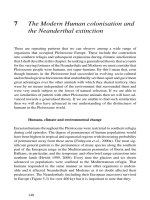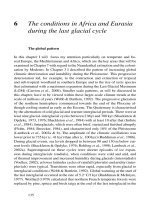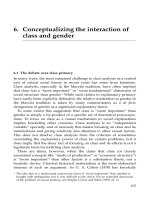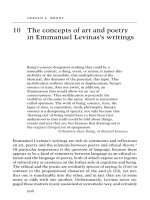the restless earth mountains and valleys
Bạn đang xem bản rút gọn của tài liệu. Xem và tải ngay bản đầy đủ của tài liệu tại đây (16.28 MB, 113 trang )
Mountains
and Valleys
T
h
e
R
e
s
T
l
e
s
s
e
a
R
T
h
tHe Restless eaRtH
Earthquakes and Volcanoes
Fossils
Layers of the Earth
Mountains and Valleys
Rivers, Lakes, and Oceans
Rocks and Minerals
Mountains
and Valleys
T
h
e
R
e
s
T
l
e
s
s
e
a
R
T
h
Mountains
and Valleys
T
h
e
R
e
s
T
l
e
s
s
e
a
R
T
h
Carolyn Arden
MOUNTAINS AND VALLEYS
Copyright © 2009 by Infobase Publishing
All rights reserved. No part of this book may be reproduced or utilized in
any form or by any means, electronic or mechanical, including photocopying,
recording, or by any information storage or retrieval systems, without permission
in
wr
iting from the publisher. For information, contact:
Chelsea House
An imprint of Infobase Publishing
132 West 31st Street
New York NY 10001
L
ibr
ary of Congress Cataloging-in-Publication Data
Arden, Carolyn.
Mountains and valleys / Carolyn Arden.
p. cm. — (Restless earth)
Includes bibliographical references and index.
ISBN 978-0-7910-9707-6 (hardcover : acid-free paper) 1. Mountains—Juvenile
literature. 2. Valleys—Juvenile literature. 3. Plate tectonics—Juvenile literature. I.
Title. II. Series.
GB512.A73 2009
551.43’2—dc22 2008027079
Chelsea House books are available at special discounts when purchased in bulk
quantities for businesses, associations, institutions, or sales promotions. Please
call our Special Sales Department in New York at (212) 967-8800 or
(800) 322-8755.
You can find Chelsea House on the World Wide Web at
Text design by Erika K. Arroyo
Cover design by Ben Peterson
Printed in the United States of America
Bang EJB 10 9 8 7 6 5 4 3 2 1
This book is printed on acid-free paper.
All links and Web addresses were checked and verified to be correct at the time of
publication. Because of the dynamic nature of the Web, some addresses and links
may have changed since publication and may no longer be valid.
Contents
1
What Is a Mountain? 7
2
How the Land Changes Shape 17
3
Folded Mountains and Volcanoes 27
4
Ocean Ridges and Rift Valleys 36
5
Fault-block Mountains
and Their Valleys 46
6
Weathering and Erosion 56
7
The Power of Ice 67
8
Mapping the Future 78
Glossary 85
Bibliography 95
Further Reading 104
Picture Credits 107
Index 108
About the Author 112
▲ ▲ ▲
FEW MOUNTAINS ARE SPOKEN OF WITH SUCH AWE AS MOUNT EVEREST,
and for good reason: It is the highest place on Earth and also one
of the deadliest. For every 50 climbers who make it to the top,
one dies. The summit of Everest rises up to 29,035 feet (8,850
meters, or m). That is nearly as high as a jet flies and taller than
23 Empire State Buildings stacked up.
It is unnatural for humans to be at such a high altitude.
There is about a third less oxygen in the air than at sea level, and
the sun’s burning rays are far more powerful. Altitude sickness,
caused by a lack of oxygen in the blood, can strike anyone who
lingers too long in what climbers call the “death zone,” at an
altitude of 26,247 feet (8,000 m) or higher. Most climbers must
breathe bottled oxygen to get to the summit. Temperatures and
1
▲ ▲ ▲
What Is a Mountain?
7
“The end of the ridge and the end of the world . . . then nothing
but that clear, empty air. There was nowhere else to climb. I was
standing on the top of the world.”
—Stacy Allison, first American woman to reach
the summit of Mount Everest
8 MOUNTAINS AND VALLEYS
wind chills in the death zone are so low, frostbite quickly devel-
ops in exposed skin. Many people have lost fingers, toes, and even
the tips of their noses to Mount Everest. High winds can literally
blow a climber off the mountain. Others die by slipping on ice
and falling. Still, despite all these dangers, every year hundreds of
people try to make it to the top of the world.
At age 71, Katsusuke Yanagisawa, a retired schoolteacher from
Japan, became the oldest person to reach the top of Mount Everest,
the world’s tallest mountain. Climbing Everest is treacherous for
even the most experienced mountain climbers and requires special
equipment such as oxygen masks.
What Is a Mountain? 9
WHERE THE SNOW NEVER MELTS
The taller a mountain is, the colder it is at the top. For every 1,000
feet (305 m) of altitude, air temperature drops about 3°F. If it is
70°F (21°C) at the base of a 20,000-foot (6,096 m) mountain,
it will be 10°F (-12.2°C) on the summit. In July, the highest the
temperature gets on the summit of Mount Everest is 0°F (-18°C);
in the winter, temperatures can drop to -76°F (-60°C).
The peaks of most of the world’s tallest mountains are above
the snow line, the altitude above which snow does not melt.
This is why so many tall mountains are snow-capped even in the
Mount Kilimanjaro is the tallest mountain in Africa. It remains
snowcapped year round because its summit is above the snow line.
10 MOUNTAINS AND VALLEYS
summer. The snow line is at different altitudes in different parts
of the world, depending on the local climate.
Even though it is located close to the equator, there is snow
on top of Tanzania’s Mount Kilimanjaro because it rises 19,340
feet (5,895 m) from the flat African plains. From base to sum-
mit, Mount Kilimanjaro’s environment changes five times: from
farmland, to rain and cloud forest, to heath and moorland, to
alpine desert, to glacier.
There are lots of stories about Mount Everest, but one of the most
famous is that of George Mallory and Andrew Irvine, two British
climbers who disappeared while climbing to the summit in 1924.
On June 6, 1924,
mountaineer
and schoolteacher George
mountaineer and schoolteacher George mountaineer
Mallory, 37, and engineering student Andrew Irvine, 22, hoped to be
the first to stand on top of the world’s highest mountain. They had
made it to 26,700 feet (8,138 m), where they would leave their camp
and start the final and difficult climb to the summit. On June 8, a
geologist
spotted the climbers—looking like two black dots—close
to the summit and “going strong.” But a few hours later, thick clouds
swirled over the mountain, obscuring the view of the peak.
Mallory and Irvine were never seen again.
For decades, their fate remained a mystery. Did they get to the
top? Did they fall? Did they run out of oxygen? None of these ques-
tions could be answered because their bodies were never found.
Then, in 1999, a special expedition was launched to look for
clues to their disappearance. At nearly 27,000 feet (8,230 m) on the
North Face of Mount Everest, a grim discovery was made. The frozen
Frozen Forever:
Lost on Mount Everest
What Is a Mountain? 11
MOUNTAINS STAND TOGETHER
Mount Everest is part of the Himalaya mountain range—a wall
of rugged, snow-covered peaks 1,500 miles (2,415 kilometers)
long bordering northern India and China. The 10 highest moun-
tains in the world are found in the Himalayas, which translates
from Sanskrit to “abode of snow.”
A mountain range is a group of individual mountains that
form a line. For example, Mount Washington, the highest peak in
body of a climber lay facedown in the snow. The body was remark-
ably well preserved, with 1920s-style clothing and hobnailed boots.
Inside a pouch around his neck was a letter addressed in elegant
script to “Mr. George Leigh Mallory.”
Mallory’s frozen body had turned almost pure white. His leg was
broken and his arms were stretched uphill, his fingers clawing into
the rocks as if he were trying to stop sliding.
Irvine’s body was nowhere to be found. The expedition team
gathered artifacts from Mallory’s corpse and covered it with stones,
putting the famous mountaineer to rest 75 years after he died trying
to fulfill a dream.
Mallory’s is not the only frozen body on Mount Everest. Nearly
200 people have died on the mountain since 1921. Most of their bod-
ies are left on the mountain where they fell. It is dangerous enough
to try to climb the mountain; to bring a body back down is next to
impossible.
It is still unknown whether Mallory and Irvine died on their way
up to the summit, or on the way back down. On future expeditions,
researchers hope to recover a camera that Mallory had borrowed the
day he and Irvine left camp for the summit. Although the film would
be more than 80 years old, it could produce the missing clues to
what happened on top of Mount Everest on June 8, 1924.
12 MOUNTAINS AND VALLEYS
New Hampshire, is part of the Presidential Range, which is part
of the White Mountains chain. A mountain range can be very
long or relatively short. The Transantarctic Mountains range in
Antarctica is 2,200 miles (3,542 km) in length. The Teton Range
in Wyoming is only 40 miles (64 km) long.
Mountains can stand alone, too. Mount Kilimanjaro is a
single volcanic mountain that rises up over the flat, dry African
plains in Tanzania.
MOUNTAINS COME IN DIFFERENT SHAPES
Mountains are built up slowly, over millions of years, by forces
deep within the Earth. Geologists recognize four general catego-
ries of mountains, based on the forces that shaped them. They are
folded, volcanic, dome, and fault-block mountains.
The Himalayas are folded mountains, made when the con-
tinents of India and Asia collided tens of millions of years ago.
Folded mountains are created when pressure causes the Earth’s
crust, or outermost layer of rock, to buckle and fold into ridges
and valleys, like wrinkles in a thick towel. Some of the most
spectacular mountain ranges in the world—including the Alps in
Europe, the Urals in northern Russia, and the Andes mountains
in South America—are folded mountains.
The peaks of volcanic mountains look very different from
those of folded mountains. They are more rounded and symmet-
rical, with gently sloping sides. Volcanic mountains are formed
by vents in the Earth that allow magma, or hot, molten rock,
to reach the surface, cool, and harden into solid rock. Mount
Fuji in Japan, Mount Kenya in Africa, and Mount Rainier in
Washington are all volcanic mountains. The Hawaiian Islands
are the tops of volcanic mountains that formed on the Pacific
Ocean floor.
The gently rolling Black Hills of South Dakota are dome
mountains. Dome mountains are made when pockets of hot
lava are trapped underground and heat and pressure force rock
layers up into a dome, like a bubble in a pot of boiling soup.
What Is a Mountain? 13
The tallest mountain in the Black Hills is Harney Peak, with an
altitude of 7,242 feet (2,207 m). Mount Everest is four times
taller!
The Hawaiian Sea Monster
What is the tallest mountain on Earth? If you are thinking Mount
Everest, you are only partly right. Mount Everest is the tallest moun-
tain in terms of altitude, but the tallest mountain on Earth from base
to summit is actually out in the middle of the Pacific Ocean. It is
Mauna Kea, a volcanic mountain we know as the Big Island of Hawaii,
named “white mountain” for its snow-capped peaks.
Mauna Kea rises 33,500 feet (10,200 m) from the bottom
of the Pacific Ocean. That is almost 5,000 feet (1,524 m) taller
than Mount Everest. Only 11,000 feet (3,353 m) of Mauna Kea is
above the surface of the ocean; the other 22,000 feet (6,706 m) is
underwater.
Mauna Kea is a seamount, a volcanic mountain born on the ocean
floor. About 800,000 years ago, it began to grow from an outpour-
ing of lava at the bottom of the sea. This is how all of the Hawaiian
Islands were formed. It is a dormant, or “sleeping,”
volcano
because
it has not erupted for 4,500 years, but still could.
Because of its
elevation
and location, Mauna Kea is an ideal
spot for stargazing. The Keck Observatory, with 13 working tele-
scopes used by astronomers from 11 countries, is located at the
summit.
Mauna Kea’s summit is above the snow line in Hawaii, so snow
falls there during the winter months. Winds can reach up to 70 miles
per hour (113 kilometers per hour) at the summit. Still, some brave
souls make the two-hour drive up to the top to try skiing at the only
place they can in tropical Hawaii.
14 MOUNTAINS AND VALLEYS
Fault-block mountains form along giant cracks, or faults,
in the Earth—the same faults that cause earthquakes. It is
earthquakes that make fault-block mountains rise higher and
higher as the ground shifts on both sides of a fault. When a tilted
block of Earth slides up on one side of a fault, it forms a moun-
tain range with high walls on one side and a gradual slope on the
other. The magnificent Tetons in Wyoming, home to the famous
Jackson Hole ski area with its challenging, steep slopes, are fault-
block mountains.
IT TAKES TIME TO MAKE A MOUNTAIN
Mountains take tens of millions of years to grow. The period dur-
ing which a group of mountains is built is called an orogeny,
which comes from the Greek words oros (mountain) and genes
(born). An orogeny begins at the point when volcanic or tectonic
forces start to build or change the shape of a mountain range, and
ends when that activity stops. Some, like the orogeny that formed
the Himalayas, are still going on today.
Geologists have identified the major orogenies that created
some of the world’s most famous mountain ranges. About 250
million years ago, a series of orogenies created the Appalachians in
North America, the Massif Central in France, and the Caledonian
Mountains in Scotland and Scandinavia. The Alps in Switzerland
arose during the Alpine orogeny, 20 million years ago.
Like a house that is renovated over time to add more rooms,
a mountain chain can grow and change its shape during several
orogenies. The Rocky Mountains in western North America were
sculpted during the Sonoma (270 to 240 million years ago), the
Sevier (140 to 50 million years ago), and the Laramide orogenies
(70 to 40 million years ago).
THE FORCES THAT BRING MOUNTAINS DOWN
Almost as soon as a mountain rises up, it begins to wear down.
The forces of nature—wind, water, ice, snow, plant growth—pick
What Is a Mountain? 15
There are four basic types of mountains, identified by the geologic
forces that formed them. Volcanic mountains tend to be steeper,
with sharper peaks.
16 MOUNTAINS AND VALLEYS
away at the rock, carving valleys, lowering peaks, and wearing
the mountains down to the ground over hundreds of millions of
years. This geological process is called erosion.
Younger mountains are usually taller and pointier, with dra-
matic peaks and steep valleys, while older mountains are lower
and rounder, with gently rolling hills and valleys carved by ero-
sion over time.
Mount Everest is the tallest mountain on land today, but it
would have had some fierce competition when Earth was rela-
tively young. Geologists have discovered that the very old rocks in
an area of eastern Canada, known as the Canadian Shield, were
once part of an enormous mountain range with peaks as high as
39,600 feet (12,070 m). Today, the gently rolling landscape of
the Canadian Shield is known for its fertile farmland and peace-
ful lakes.
Some of the oldest mountains in North America are in the
Appalachian chain, which runs along the eastern seaboard from
Alabama north to Canada and first began to form 480 million
years ago. Compared to the tall and majestic Himalayas, the
Appalachians are old and stooped. Worn down by more than 100
million years of erosion, their highest peaks are only about 6,000
feet (1,829 m) in elevation. In their younger days, however, the
“ancient” eastern Appalachians were closer in height to the soar-
ing western Rocky Mountains of today.
The Appalachians have a violent past that goes back hundreds
of millions of years and includes earthquakes, colliding conti-
nents, and explosive volcanoes. Like most of the world’s great
mountains, the Appalachians were born when the earth moved.
17
▲ ▲ ▲
MOUNT EVEREST IS STILL RISING—ABOUT 0.4 INCHES (1 CENTIMETER)
each year. At this rate, the mountain could be 2,500 feet (760 m)
higher a thousand years from now. That is almost half a mile!
Mount Everest keeps growing because the continents of India and
Asia, which collided millions of years ago, are still moving toward
each other.
How can continents move? This was a question pondered
by German scientist Alfred Wegener in the early 1900s, and it
eventually led to one of the most important mountain-building
concepts in geology: plate tectonics.
THE MOVEMENT OF CONTINENTS
Wegener was studying a map of the world when he noticed
something strange. The continents of South America and Africa
seemed to fit together like puzzle pieces if they were pushed
together across the Atlantic Ocean. (Dutch mapmaker Abraham
Ortelius had noticed this too, in 1596.)
Wegener looked for other similarities between the two conti-
nents. He compared rock structures on the eastern coast of South
2
How the Land
Changes Shape
18 MOUNTAINS AND VALLEYS
America with those on the western coast of Africa. He examined
plant and animal fossils from both continents.
He discovered that the rocks and fossils dating back a few
hundred million years were almost identical. How could this be?
Africa and South America are separated today by the wide Atlantic
The continents were not always located where they are today.
According to the theory of continental drift, they started out
together as one huge landmass called Pangaea, then moved slowly
over time to their present locations.
How the Land Changes Shape 19
Ocean, and their native animals are very different. Sloths, for
example, are found in South America, not Africa. Zebras are
found in Africa, not South America. The rock and fossil evidence
suggested to Wegener that perhaps the two continents were
joined together long ago, splitting apart later like a painting that
is ripped into two pieces.
Based on this idea, Wegener came up with a bold new theory
he called continental drift. He proposed that one big supercon-
tinent called Pangaea had existed on Earth approximately 225
million years ago. Over time, it broke apart into giant pieces that
“drifted” into place to form the world map as we know it today.
PLATE TECTONICS
It would be quite a while before the scientific community would
accept Wegener’s unusual theory. In 1967, two scientists, W.
Jason Morgan of Princeton University in New Jersey, and Dan
McKenzie of Cambridge University in England, happened to come
up with another theory at about the same time. Known today as
plate tectonics, it combines continental drift with new findings
about the ocean floor to explain how and why the Earth’s surface
is always changing.
To understand plate tectonics, it helps to visualize what our
planet looks like below the surface. If Earth were cut in half like
a hard-boiled egg, the yolk would be its solid metallic core and
the egg white would be the mantle—all of the material that lies
between the core and the the outermost layer, the crust. It is the
crust, the eggshell in our hard-boiled egg model of Earth, that
changes shape to form mountains, valleys, and other landscape
features.
There are two kinds of crust: continental and oceanic.
Continental crust is made of relatively light minerals such as
quartz and feldspar and is 15 to 30 miles thick (24 to 48 km).
Oceanic crust is only 3 to 5 miles thick (5 to 8 km) but is made
of heavier, dense volcanic rock. Both kinds of crust will break and
fold if enough force is applied.
Most of the mantle is hot, molten rock, but the mantle layer
just below the crust is cooler and rigid and behaves like solid
20 MOUNTAINS AND VALLEYS
rock. This mantle layer and the crust that sits on top of it make
up what is called the Earth’s lithosphere. The lithosphere is up
to 60 miles (100 km) thick.
The Earth is made up of many layers. The thinnest, outermost
layer, the crust, is divided into two types: oceanic crust and
continental crust. It is the crust that changes shape to form
mountains and valleys.
How the Land Changes Shape 21
In plate tectonics theory, the lithosphere is broken into giant
slabs called tectonic plates that fit together like puzzle pieces
to cover the globe. There are eight major plates, and several
smaller ones. Some plates are so big, they carry more than one
continent and parts of oceans, too. For example, the North
American plate holds all of North America, Greenland, part of
Russia, and portions of the Pacific Ocean, the Atlantic Ocean,
and the Caribbean Sea.
The tectonic plates “float” on a mantle layer called the
asthenosphere, made of hot, thick magma that flows like
Bikinis in Antarctica?
Scientists who do research in Antarctica are a brave bunch. Antarctica
is the coldest place on Earth, mostly covered with ice and snow. It
holds the world record for the lowest temperature ever recorded on
Earth: -129°F (-89°C) on July 21, 1983, at a research station called
Vostok. To stay warm, scientists wear lots of layers: thermal under-
wear, wind pants, flannel shirt, polar fleece, and a big polar parka.
If they had worked in Antarctica about 250 million years ago,
they could have worn shorts and bathing suits instead.
By examining rocks and fossils, geologists have discovered that
the frozen continent had a tropical past. For example, layers of sand-
stone located just a few hundred miles from the South Pole contain
coal, a deposit that forms in moist, warm climates. Fossils of ferns
and trees have also been collected.
In 1969, geologists discovered the fossil bones of
Lystrosaurus
,
an ancient reptile about the size of a large dog that lived between
180 and 225 million years ago. Until then,
Lystrosaurus
had only
been found in Africa, India, and China.
In 1995, the remains of an armadillolike creature the size of a
small car were found, and, in 1998, researchers unearthed a duck-
(continues)
22 MOUNTAINS AND VALLEYS
warm caramel. Heat circulating from the lower mantle to
the asthenosphere and back again, known as convection cur-
rents, helps the plates move around like broken crackers in hot
soup—slowly sliding past each other, pushing together, and
pulling apart.
We cannot see the tectonic plates move any more than we
can see a mountain grow. The plates move very slowly, only a few
inches per year on average.
billed dinosaur, an ancient bird, and huge marine reptiles. All of these
fossils had been seen before in Africa, Australia, South America, and
India—continents adjacent to Antarctica. How could these creatures
have made the long, ocean-crossing journey to Antarctica? Although
it’s easy to imagine how the marine fossils might have gotten there,
what about the terrestrial animals?
One explanation is Wegener’s theory of continental drift. If these
continents were all connected at some time in the past, the animals
could have spread across the supercontinent, allowing their remains
to be deposited as fossils in various places.
The fossil evidence found in Antarctica supports the theory of
continental drift—that the continents of the world were once joined
together as one huge landmass, breaking apart over time and drifting
into their present-day positions. Geologists have since determined
that about 250 million years ago, Antarctica was joined to Africa,
Australia, South America, and India and that they were all much
closer to the equator. The climate on the chunk of land that would
break off to become Antarctica was warm and tropical, similar to a
South American rain forest.
It may be hard to imagine today, but if humans had been around
then, Antarctica might have been a nice place to spread out a towel,
grab a good book, and soak up some sun.
(continued)
How the Land Changes Shape 23
PLATE BOUNDARIES: WHERE THE ACTION IS
The seams where plates fit together are called plate boundaries.
Some plate boundaries are on the ocean floor. Others follow the
outlines of continents. The western coast of South America lies
along the seam of the Nazca and South American plates, and the
western coast of North America lines up with the edge of the
Pacific and North American plates.
Two plates can move toward each other, pull apart, or slide past
each other. At active plate boundaries, mountains and valleys form,
earthquakes rumble, and volcanoes blow. The interactions of the
plates over time cause dramatic changes in the Earth’s crust.
The Earth’s plates are constantly in motion, although it is too slow
to notice. The contact between the plates is what causes mountains
to form, volcanoes to erupt, and earthquakes to shake.
24 MOUNTAINS AND VALLEYS
The line of intersection where two plates are moving toward
each other is called a convergent boundary. If both are con-
tinental plates—that is, they carry landmasses—the crust can
crumple up into the folds of a mountain range.
But when a thinner, heavier oceanic plate meets a thicker,
lighter continental plate, the oceanic plate often dives down
beneath the other plate. This downward dive is called subduc-
tion. As the plates keep pushing together, the oceanic plate dives
deeper into the Earth, eventually melting and sending hot magma
back up to the surface to form volcanic mountains. The Cascade
Mountains, on the northwestern coast of the United States, were
formed in this way, as were the Andes in South America.
The Moving Seafloor
When scientists mapped the ocean floor in the 1950s, they discov-
ered an enormous underwater mountain chain. It was more than
31,000 miles (50,000 km) long and more than 1,000 miles (1,600
km) wide, with towering peaks and deep valleys. This chain, called
the
mid-ocean ridge
, zigzags around the continents like the stitch-
ing on a baseball. All along its length, it is split by a deep
trench
,
more than a mile (1.6 km) deep in some places.
The seafloor maps also showed a number of deep, narrow trench-
es far from the mid-ocean ridge. These other trenches ran parallel to
coastal mountain ranges and island arcs. The deepest is the Mariana
Trench in the South Pacific Ocean, near Guam. It plunges more than
6 miles (10 km) below the ocean’s surface.
U.S. Navy captain and Princeton University geologist Harry
H. Hess, who surveyed the Pacific Ocean during World War II, was
intrigued by these new findings. Like other geologists, he also won-
dered why drilling samples had shown that the
sediment
on the









